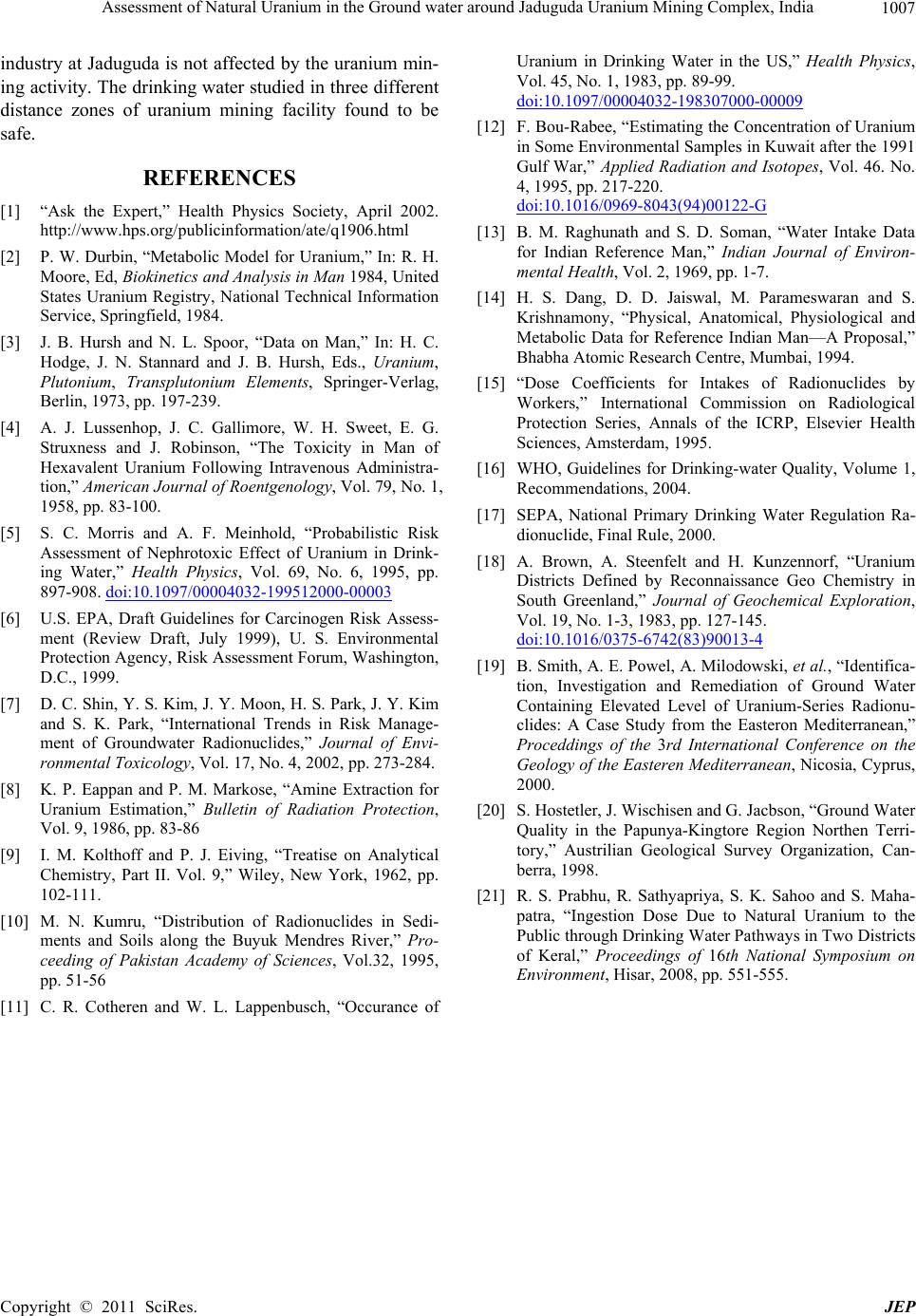
Assessment of Natural Uranium in the Ground water around Jaduguda Uranium Mining Complex, India1007
industry at Jaduguda is not affected by the uranium min-
ing activity. The drinking water studied in three different
distance zones of uranium mining facility found to be
safe.
REFERENCES
[1] “Ask the Expert,” Health Physics Society, April 2002.
http://www.hps.org/publicinformation/ate/q1906.html
[2] P. W. Durbin, “Metabolic Model for Uranium,” In: R. H.
Moore, Ed, Biokinetics and Analysis in Man 1984, United
States Uranium Registry, National Technical Information
Service, Springfield, 1984.
[3] J. B. Hursh and N. L. Spoor, “Data on Man,” In: H. C.
Hodge, J. N. Stannard and J. B. Hursh, Eds., Uranium,
Plutonium, Transplutonium Elements, Springer-Verlag,
Berlin, 1973, pp. 197-239.
[4] A. J. Lussenhop, J. C. Gallimore, W. H. Sweet, E. G.
Struxness and J. Robinson, “The Toxicity in Man of
Hexavalent Uranium Following Intravenous Administra-
tion,” American Journal of Roentgenology, Vol. 79, No. 1,
1958, pp. 83-100.
[5] S. C. Morris and A. F. Meinhold, “Probabilistic Risk
Assessment of Nephrotoxic Effect of Uranium in Drink-
ing Water,” Health Physics, Vol. 69, No. 6, 1995, pp.
897-908. doi:10.1097/00004032-199512000-00003
[6] U.S. EPA, Draft Guidelines for Carcinogen Risk Assess-
ment (Review Draft, July 1999), U. S. Environmental
Protection Agency, Risk Assessment Forum, Washington,
D.C., 1999.
[7] D. C. Shin, Y. S. Kim, J. Y. Moon, H. S. Park, J. Y. Kim
and S. K. Park, “International Trends in Risk Manage-
ment of Groundwater Radionuclides,” Journal of Envi-
ronmental Toxicology, Vol. 17, No. 4, 2002, pp. 273-284.
[8] K. P. Eappan and P. M. Markose, “Amine Extraction for
Uranium Estimation,” Bulletin of Radiation Protection,
Vol. 9, 1986, pp. 83-86
[9] I. M. Kolthoff and P. J. Eiving, “Treatise on Analytical
Chemistry, Part II. Vol. 9,” Wiley, New York, 1962, pp.
102-111.
[10] M. N. Kumru, “Distribution of Radionuclides in Sedi-
ments and Soils along the Buyuk Mendres River,” Pro-
ceeding of Pakistan Academy of Sciences, Vol.32, 1995,
pp. 51-56
[11] C. R. Cotheren and W. L. Lappenbusch, “Occurance of
Uranium in Drinking Water in the US,” Health Physics,
Vol. 45, No. 1, 1983, pp. 89-99.
doi:10.1097/00004032-198307000-00009
[12] F. Bou-Rabee, “Estimating the Concentration of Uranium
in Some Environmental Samples in Kuwait after the 1991
Gulf War,” Applied Radiation and Isotopes, Vol. 46. No.
4, 1995, pp. 217-220.
doi:10.1016/0969-8043(94)00122-G
[13] B. M. Raghunath and S. D. Soman, “Water Intake Data
for Indian Reference Man,” Indian Journal of Environ-
mental Health, Vol. 2, 1969, pp. 1-7.
[14] H. S. Dang, D. D. Jaiswal, M. Parameswaran and S.
Krishnamony, “Physical, Anatomical, Physiological and
Metabolic Data for Reference Indian Man—A Proposal,”
Bhabha Atomic Research Centre, Mumbai, 1994.
[15] “Dose Coefficients for Intakes of Radionuclides by
Workers,” International Commission on Radiological
Protection Series, Annals of the ICRP, Elsevier Health
Sciences, Amsterdam, 1995.
[16] WHO, Guidelines for Drinking-water Quality, Volume 1,
Recommendations, 2004.
[17] SEPA, National Primary Drinking Water Regulation Ra-
dionuclide, Final Rule, 2000.
[18] A. Brown, A. Steenfelt and H. Kunzennorf, “Uranium
Districts Defined by Reconnaissance Geo Chemistry in
South Greenland,” Journal of Geochemical Exploration,
Vol. 19, No. 1-3, 1983, pp. 127-145.
doi:10.1016/0375-6742(83)90013-4
[19] B. Smith, A. E. Powel, A. Milodowski, et al., “Identifica-
tion, Investigation and Remediation of Ground Water
Containing Elevated Level of Uranium-Series Radionu-
clides: A Case Study from the Easteron Mediterranean,”
Proceddings of the 3rd International Conference on the
Geology of the Easteren Mediterranean, Nicosia, Cyprus,
2000.
[20] S. Hostetler, J. Wischisen and G. Jacbson, “Ground Water
Quality in the Papunya-Kingtore Region Northen Terri-
tory,” Austrilian Geological Survey Organization, Can-
berra, 1998.
[21] R. S. Prabhu, R. Sathyapriya, S. K. Sahoo and S. Maha-
patra, “Ingestion Dose Due to Natural Uranium to the
Public through Drinking Water Pathways in Two Districts
of Keral,” Proceedings of 16th National Symposium on
Environment, Hisar, 2008, pp. 551-555.
Copyright © 2011 SciRes. JEP